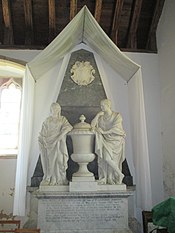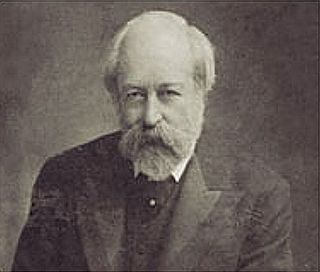
George Frederick Bodley was an English Gothic Revival architect. He was a pupil of Sir George Gilbert Scott, and worked in partnership with Thomas Garner for much of his career. He was one of the founders of Watts & Co.

St Mary's Church is an Anglican parish church in Nantwich, Cheshire, England. The church is recorded in the National Heritage List for England as a designated Grade I listed building. It has been called the "Cathedral of South Cheshire" and it is considered by some to be one of the finest medieval churches, not only in Cheshire, but in the whole of England. The architectural writer Raymond Richards described it as "one of the great architectural treasures of Cheshire", and Alec Clifton-Taylor included it in his list of "outstanding" English parish churches.
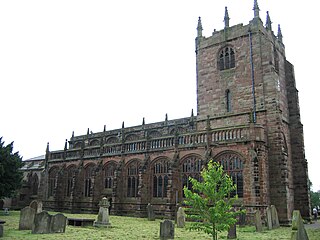
St Boniface's Church stands prominently in the village of Bunbury, Cheshire, England. It is recorded in the National Heritage List for England as a designated Grade I listed building. The church dates mainly from the 14th century. Its features include the Ridley chapel, the alabaster chest tomb of Sir Hugh Calveley and the tomb of Sir George Beeston. Raymond Richards, author of Old Cheshire Churches, considers it is architecturally one of the most important examples of its period in Cheshire. Alec Clifton-Taylor includes it in his list of 'best' English parish churches, and Simon Jenkins assigns it two stars in his book England's Thousand Best Churches. It is an active Anglican parish church in the diocese of Chester, the archdeaconry of Chester and the deanery of Malpas. Its benefice is combined with that of St Jude, Tilstone Fearnall.

St James' Church is in the village of Gawsworth, Cheshire, England, and is sited near Gawsworth Hall. It is recorded in the National Heritage List for England as a designated Grade I listed building. It is an active Anglican parish church in the diocese of Chester, the archdeaconry of Macclesfield and the deanery of Macclesfield. Clifton-Taylor includes it in his list of 'best' English parish churches. The authors of the Buildings of England series describe the church as being "pretty, but odd".
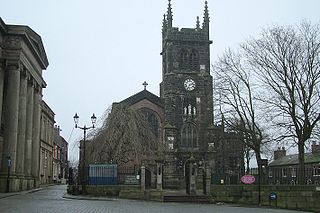
St Michael and All Angels Church overlooks Market Place in the town of Macclesfield, Cheshire, England. It is an active Anglican parish church in the diocese of Chester, the archdeaconry of Macclesfield and the deanery of Macclesfield. It forms a team parish with three other Macclesfield churches: All Saints, St Peter's and St Barnabas'. The church is recorded in the National Heritage List for England as a designated Grade II* listed building.

St Chad's Church, Over, is in the town of Winsford, Cheshire, England. It was formerly in the separate town of Over, but with the growth of Winsford it has become part of that town. The church is recorded in the National Heritage List for England as a designated Grade II* listed building. It is an active Anglican parish church in the diocese of Chester, the archdeaconry of Chester and the deanery of Middlewich.
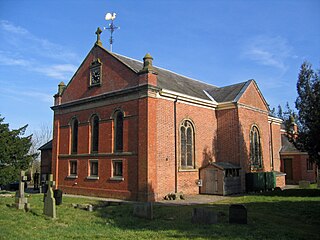
St Mary's and St Michael's Church is in the village of Burleydam in the civil parish of Dodcott cum Wilkesley, Cheshire, England. The church is some 1.5 miles (2 km) to the southeast of Combermere Abbey. It is recorded in the National Heritage List for England as a designated Grade II listed building. It is an active Anglican parish church in the diocese of Chester, the archdeaconry of Macclesfield and the deanery of Nantwich. Its benefice is combined with those of St Michael, Baddiley, and St Margaret, Wrenbury.

St Michael and All Angels Church is an Anglican church in the town of Southwick in the district of Adur, one of seven local government districts in the English county of West Sussex. Some Saxon-era structural work is still visible despite rebuilding work in the 12th and 13th centuries and in more recent times; and a church may have existed on the site as early as the 10th century—before the ancient settlement of Southwick even took that name. The church has been damaged by fire and bombing, but is still in active use as the area's parish church. English Heritage has listed it at Grade II* for its architectural and historical importance.
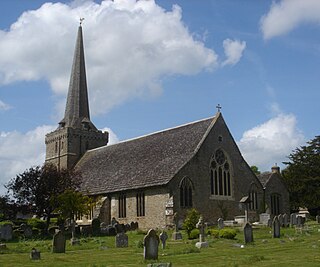
Holy Trinity Church is an Anglican church in the village of Cuckfield in the district of Mid Sussex; one of seven local government districts in the English county of West Sussex. It was founded in the 11th century and was in the possession of Lewes Priory by 1090. The present structure dates from the mid-13th century but was extended in the 14th century and heavily altered and restored during the Victorian period, with much interior work by Charles Eamer Kempe and stained glass by both Kempe and the Clayton and Bell firm. The church's spire was replaced in 1981 following a fire. Former chapels of ease in outlying hamlets have closed, and the church now serves a large rural area in the centre of Sussex. It is protected as a Grade I listed building.

St Mary's Church is an Anglican church in the village of Slaugham in Mid Sussex, one of seven local government districts in the English county of West Sussex. The 12th- and 13th-century church, restored in the Victorian era, serves a large rural area of the Sussex Weald, covering three villages as well as the ancient settlement of Slaugham. It also controlled the church in the market town of Crawley—now one of the area's largest towns—for the first few centuries of its existence. A locally important family built a private chapel in the church in the 17th century, and a series of memorials to deceased family members are considered to be excellent examples of their type. English Heritage has listed the building at Grade II* for its architectural and historical importance.

St George's Church, Beckenham is the Church of England parish church of Beckenham, Greater London. It is Grade II* listed.

Preston Minster, formally the Minster Church of St John the Evangelist, is in Church Street, in the centre of Preston, Lancashire, England. From its origin it has been the parish church of Preston. It is an active Anglican church in the deanery of Preston, the archdeaconry of Lancaster and the diocese of Blackburn. Its benefice is united with that of St George, Preston. St John's is recorded in the National Heritage List for England as a designated Grade II* listed building.

St Michael and All Angels Church is a late nineteenth-century church in the settlement of Partridge Green in the parish of West Grinstead in West Sussex. It was built to cater for the then growing population of the village. Ian Nairn, in the Sussex volume of The Buildings of England, approves of the simplicity of this "flint village church" and comments that most "other counties would have had it much fussier". St Michael and All Angels' shares its mission with the parish church of St George's Church, West Grinstead.

St Margaret's Church is an Anglican church in the village of West Hoathly in Mid Sussex, one of seven local government districts in the English county of West Sussex.

St Peter and St Paul's Church is in Gisburn Road, Bolton-by-Bowland, Lancashire, England. It is an active Anglican parish church in the deanery of Whalley, the archdeaconry of Blackburn, and the Diocese of Blackburn. Its benefice is united with that of St Ambrose, Grindleton. The church is recorded in the National Heritage List for England as a designated Grade I listed building.

St Mary's Church is in the village of Hopesay, Shropshire, England. It is an active Anglican parish church in the deanery of Clun Forest, the archdeaconry of Ludlow, and the diocese of Hereford. The church is recorded in the National Heritage List for England as a designated Grade I listed building.

Holy Trinity Church, Micklegate, York is a Grade I listed parish church in the Church of England in York.

The Church of St Katharine of Alexandria is the Church of England parish church for Ickleford in Hertfordshire. It comes under the diocese of St Albans.

St Peter's Church is a Church of England parish church in the large village of Henfield, West Sussex. Placed on the site of an 8th-century Saxon church also dedicated to St Peter, it was built in the 13th, 14th and 15th centuries, but was heavily restored and partially rebuilt in the 19th century. English Heritage has listed it at Grade II* for its architectural and historical importance. Services for the parish continue and also cover the parishes of St Giles', Shermanbury and St. Peter's, Woodmancote, which form its united benefice.
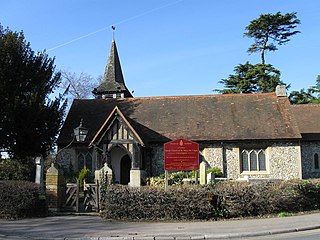
St Mary the Virgin's Church, Chessington is a Grade II listed building, in Church Lane, Chessington, in the Royal Borough of Kingston upon Thames within Greater London. It is in the Diocese of Guildford. It became a separate parish from St. John the Baptist, Old Malden, in 1939.


